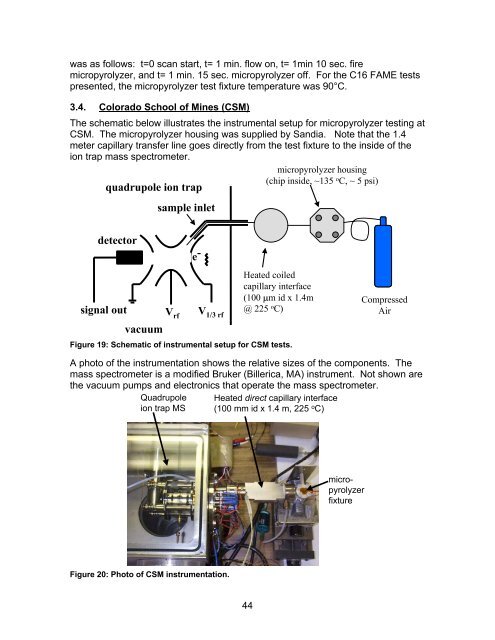Miniature Sensors for Biological Warfare Agents using Fatty Acid ...
Miniature Sensors for Biological Warfare Agents using Fatty Acid ...
Miniature Sensors for Biological Warfare Agents using Fatty Acid ...
You also want an ePaper? Increase the reach of your titles
YUMPU automatically turns print PDFs into web optimized ePapers that Google loves.
was as follows: t=0 scan start, t= 1 min. flow on, t= 1min 10 sec. fire<br />
micropyrolyzer, and t= 1 min. 15 sec. micropyrolyzer off. For the C16 FAME tests<br />
presented, the micropyrolyzer test fixture temperature was 90°C.<br />
3.4. Colorado School of Mines (CSM)<br />
The schematic below illustrates the instrumental setup <strong>for</strong> micropyrolyzer testing at<br />
CSM. The micropyrolyzer ho<strong>using</strong> was supplied by Sandia. Note that the 1.4<br />
meter capillary transfer line goes directly from the test fixture to the inside of the<br />
ion trap mass spectrometer.<br />
micropyrolyzer ho<strong>using</strong><br />
(chip inside, ~135 oC, ~ 5 psi)<br />
signal out<br />
quadrupole ion trap<br />
detector<br />
vacuum<br />
sample inlet<br />
V rf<br />
e -<br />
V 1/3 rf<br />
Heated coiled<br />
capillary interface<br />
(100 µm id x 1.4m<br />
@ 225 o C)<br />
Figure 19: Schematic of instrumental setup <strong>for</strong> CSM tests.<br />
44<br />
Compressed<br />
Air<br />
A photo of the instrumentation shows the relative sizes of the components. The<br />
mass spectrometer is a modified Bruker (Billerica, MA) instrument. Not shown are<br />
the vacuum pumps and electronics that operate the mass spectrometer.<br />
Quadrupole<br />
ion trap MS<br />
Figure 20: Photo of CSM instrumentation.<br />
Heated direct capillary interface<br />
(100 mm id x 1.4 m, 225 o C)<br />
micropyrolyzer<br />
fixture
















